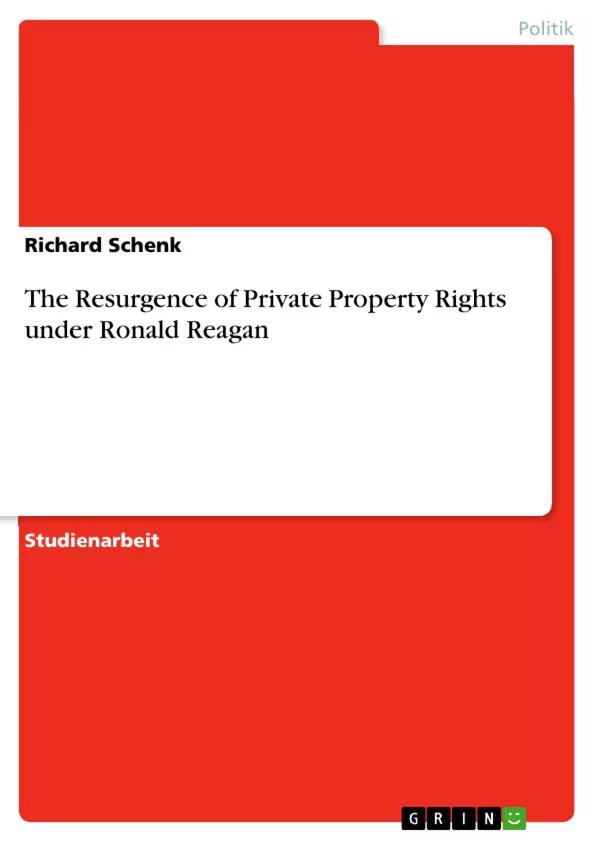This paper analyses the environmental policy process in the United States from January 1981 to January 1993. Though by focusing only on policy formulation, implementation and evaluation one cannot gain a causal understanding of behavior, this approach is adequate to gain a basic understanding of the environmental policy during the Reagan and the Bush presidencies.
Chapter 2 examines formulation of environmental policy by the two main protagonists of American politics, which of course are the presidency for the executive branch and Congress for the legislative branch.
Chapter 3 is about implementation of environmental policy in this era as shown by the two examples of the Environmental Protection Agency and a short survey of environmental protection legislation by Congress. The EPA should characterize the environmental policy pursued by the administration. In contrast the survey should highlight the approach of the Congress towards environmental policy. Did the Democratic majority in the House succeed in fortifying the previous decade’s progress in environmental protection?
Chapter 4 is an attempt to answer the main question by trying to identify the main direction of environmental policy of this era. Have the presidents succeeded with their approach to environmental policy and how did this influence the United States in the following decades? If one specifies progress and regress in environmental policy in their period, which one prevails? Unfortunately this questions cannot be answered adequately due to the length of the paper, but the results should provide a satisfactory overview of this complex topic that combines very different facets of policy and politics.
Inhaltsverzeichnis
- General Introduction
- Introduction and Problem Identification
- Scientific Approach
- The Two Main Variables of American Environmental Policy Formulation
- The Authority of the Executive Branch
- The Reagan and the Bush presidencies and Their Environmental Agenda
- Environmental policy-making in the legislative branch.
- Implementation: Administration and Legislation
- Environmental Legislation
- Policy of the Environmental Protection Agency
- Concluding Thoughts
Zielsetzung und Themenschwerpunkte
Diese Arbeit analysiert die Entwicklung der Umweltpolitik in den Vereinigten Staaten während der Reagan- und Bush-Administrationen von 1981 bis 1993. Sie untersucht die Formulierung und Umsetzung von Umweltpolitik durch die Exekutive und die Legislative, mit besonderem Fokus auf die Rolle der Environmental Protection Agency (EPA). Ziel ist es, die wichtigsten Trends und Entwicklungen in der amerikanischen Umweltpolitik in dieser Zeit zu identifizieren und zu bewerten.
- Die Rolle der Exekutive in der Umweltpolitik
- Die Umweltpolitik der Reagan- und Bush-Administrationen
- Die Bedeutung der Environmental Protection Agency (EPA)
- Der Einfluss des Kongresses auf die Umweltpolitik
- Die Entwicklung der Umweltpolitik in den Vereinigten Staaten zwischen 1981 und 1993
Zusammenfassung der Kapitel
Das erste Kapitel führt in die Problematik der Umweltpolitik in den Vereinigten Staaten während der Reagan- und Bush-Administrationen ein. Es stellt die Forschungsfrage und die wissenschaftliche Herangehensweise vor. Kapitel 2 analysiert die Rolle der Exekutive und der Legislative in der Formulierung von Umweltpolitik. Es beleuchtet die Machtstrukturen und die verschiedenen Akteure, die an der Gestaltung der Umweltpolitik beteiligt sind. Kapitel 3 befasst sich mit der Umsetzung von Umweltpolitik, wobei die EPA als Beispiel für die Vorgehensweise der Regierung und die Gesetzgebung des Kongresses als Beispiel für die Rolle des Gesetzgebers herangezogen werden.
Schlüsselwörter
Die Arbeit konzentriert sich auf die Umweltpolitik der Vereinigten Staaten unter den Präsidenten Ronald Reagan und George H.W. Bush. Wichtige Themen sind die Rolle der Exekutive und der Legislative in der Gestaltung von Umweltpolitik, die Bedeutung der Environmental Protection Agency (EPA) und die Entwicklung der Umweltpolitik in den Vereinigten Staaten zwischen 1981 und 1993.
- Quote paper
- Richard Schenk (Author), 2015, The Resurgence of Private Property Rights under Ronald Reagan, Munich, GRIN Verlag, https://www.grin.com/document/298858



